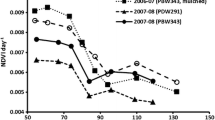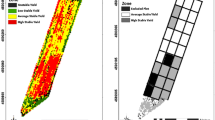Abstract
A site-specific nitrogen fertilizer application system that uses optical reflectance measurements of growing wheat plants to estimate N requirements has been developed. The machine enables unique applications of liquid N fertilizer at a grid level of 0.37 m2. To achieve widespread adoption, the precision application system must be efficient enough to overcome the cost advantage of pre-plant applications of anhydrous ammonia (NH3) relative to top-dress applications of either dry or liquid N sources on growing wheat. The objective of this research is to determine if the system is more profitable than conventional methods. Data from on-farm N fertilizer experiments were collected across three years and nine locations in the Southern Plains of the U.S.A. Net returns were calculated for each of eight treatments. The site-specific precision system was competitive economically, but it was not unambiguously superior to the conventional alternatives because it could not overcome the cost advantage of NH3 pre-plant N sources relative to the cost of applying urea-ammonium nitrate (UAN) during the growing season. The value of the precision system is sensitive to the price of UAN relative to the price of NH3.
Similar content being viewed by others
Notes
Parameter estimates were shifted one standard deviation to the left in an effort by Raun et al. (2002) to describe a yield boundary.
The level of N applied to the NRS (kg ha−1) is equal to 0.0417 kg times the expected maximum potential yield of the field (kg ha−1). In this study the average expected maximum potential yield was assumed to be 3,225 kg ha−1.
References
Alchanatis, V., Scmilovitch, Z., & Meron, M. (2005). In-field assessment of single leaf nitrogen status by spectral reflectance measurement. Precision Agriculture, 6, 25–39.
American Society of Agricultural, Biological Engineers. (2006). Agricultural machinery management data. ASAE D497.5. MI, USA: St. Joseph.
Biermacher, J., Epplin, F. M., Brorsen, B. W., Solie, J. B., & Raun, R. W. (2006). Maximum value of a precise nitrogen application system for wheat. Precision Agriculture, 7, 193–204.
Bullock, D. S., Lowenberg-Deboer, J., & Swinton, S. M. (2002). Adding value to spatially managed inputs by understanding site-specific yield response. Agricultural Economics, 27, 233–245.
Carr, P. M., Carlson, G. R., Jacobson, J. S., Nielson, G. A., & Skogley, E. O. (1991). Farming soils, not fields: A strategy for increasing fertilizer profitability. Journal of Production Agriculture, 4, 57–67.
Ehlert, D., Schmerler, J., & Voelker, U. (2004). Variable rate nitrogen fertilisation of winter wheat based on a crop density sensor. Precision Agriculture, 5, 263–273.
Frank, M. D., Beattie, B. R., & Embleton, M. E. (1990). A comparison of alternative crop response models. American Journal of Agricultural Economics, 72, 597–603.
Grimm, S. S., Paris, Q., & Williams, W. A. (1987). A von Liebig model for water and nitrogen crop response. Western Journal of Agricultural Economics, 12, 182–192.
Haneklaus, S., Schroeder, D., & Schnug, E. (1999). Decision making strategies for fertilizer use in precision agriculture. In P. C. Roberts, R. H. Rust, & W. E. Larson (Eds.), Proceedings of the 4th International Conference on Precision Agriculture (pp.1757–1765). Madison, WI, USA: ASA/CSSA/SSSA.
Kletke, D., & Doye, D. (2001). Oklahoma farm and ranch custom rates, 2001–2002. Stillwater, OK, USA: Oklahoma Cooperative Extension (Current report CR-205).
Lambert, D. M., Lowenberg-Deboer, J., & Malzer, G. L. (2006). Economic analysis of spatial-temporal patterns in corn and soybean response to nitrogen and phosphorus. Agronomy Journal, 98, 43–54.
Large, E. C. (1954). Growth stages in cereals. Plant Pathology, 3, 128–129.
Oklahoma Cimatological Survey. (2007). Oklahoma climate data. http://climate.mesonet.org/rainfall_update.html. Accessed February 2008.
Oklahoma Mesonet. (2007). Soil characteristics. http://www.mesonet.org/sites. Accessed February 2008.
Phillips, S. B., Keahey, D. A., Warren, J. G., & Mullins, G. L. (2004). Estimating winter wheat tiller density using spectral reflectance sensors for early-spring, variable rate nitrogen application. Agronomy Journal, 96, 591–600.
Raun, W. R., Solie, J. B., Johnson, G. V., Stone, M. L., Mullen, R. W., Freeman, K. W., et al. (2002). Improving nitrogen use efficiency in cereal grain production with optical sensing and variable rate application. Agronomy Journal, 94, 815–820.
Raun, W. R., Solie, J. B., Johnson, G. V., Stone, M. L., Whitney, R. W., Lees, H. L., et al. (1998). Microvariability in soil test, plant nutrient, and yield parameters in bermudagrass. Soil Science Society of American Journal, 62, 683–690.
Raun, W. R., Solie, J. B., Stone, M. L., Freeman, K. W., Mullen, R. W., Zhang, H., et al. (2005). Optical sensor based algorithm for crop nitrogen fertilization. Communications of Soil Science and Plant Analysis, 36, 2759–2781.
Schachtl, J., Huber, G., Maidl, F.-X., Stickse, E., Schulz, J., & Haschberger, P. (2005). Laser-induced chlorophyll fluorescence measurements for detecting the nitrogen status of wheat (Triticum aestivum L.) canopies. Precision Agriculture, 6, 143–156.
Solie, J. B., Raun, W. R., & Stone, M. L. (1999). Submeter spatial variability of selected soil and bermudagrass production variables. Soil Science Society of American Journal, 63, 1724–1733.
Solie, J. B., Raun, W. R., Whitney, R. W., Stone, M. L., & Ringer, J. D. (1996). Optical sensor based field element size and sensing strategy for nitrogen application. Transactions of the ASAE, 39, 1983–1992.
Solie, J. B., Stone, M. L., Raun, W. R., Johnson, G. V., Freeman, K. W., Mullen, R. W., et al. (2002). Real-time sensing and N fertilization with a field scale GreenseekerTM applicator. http://nue.okstate.edu/Papers/Minnesota_2002_Solie.htm. Accessed November 2003.
Stone, M. L., Solie, J. B., Whitney, R. W., Raun, W. R., & Lees, H. L. (1996). Sensors for detection of nitrogen in winter wheat. SAE Tech. Pap. Ser. 961757. Soc. of automotive eng. PA, USA: Warrendale.
Swinton, S. M., & Lowenberg-DeBoer, J. (1998). Evaluating the profitability of site-specific farming. Journal of Production Agriculture, 11, 439–446.
Tembo, G., Brorsen, B. W., Epplin, F. M., & Tostão, E. (2008). Crop input response functions with stochastic plateaus. American Journal of Agricultural Economic, 90(2), 424–434.
USDA. (2007a). Quick stats. National agricultural statistics service. http://www.nass.usda.gov/QuickStats/PullData_US.jsp. Accessed February 2008.
USDA. (2007b). Economics, statistics, and market information system, National agricultural statistics service. http://usda.mannlib.cornell.edu/MannUsda/viewDocumentInfo.do?documentID=1003. Accessed February 2008.
Waugh, D. L., Cate, R. B., & Nelson, L. A. (1973). Discontinuous models for rapid correlation, interpretation and utilization of soil analysis and fertilizer response data. North Carolina State University Technical Bulletin No. 7, Soil fertility evaluation and improvement program. SC, USA: Raleigh.
Whipker, L. D., & Akridge, J. T. (2007). 2007 precision agricultural services dealership survey results. Working paper # 07–13, Department of Agricultural Economics, Purdue University, West Lafayette, IN. http://www.agriculture.purdue.edu/ssmc/publications/2007_Presicion_Ag.pdf. Accessed March 31 2008.
Acknowledgments
The authors gratefully thank the editors and two anonymous journal reviewers for their constructive comments. The project was supported by the USDA Cooperative State Research, Education and Extension Service, Hatch grant number H-2574 and by the Oklahoma Agricultural Experiment Station.
Author information
Authors and Affiliations
Corresponding author
Rights and permissions
About this article
Cite this article
Biermacher, J.T., Epplin, F.M., Brorsen, B.W. et al. Economic feasibility of site-specific optical sensing for managing nitrogen fertilizer for growing wheat. Precision Agric 10, 213–230 (2009). https://doi.org/10.1007/s11119-008-9092-y
Published:
Issue Date:
DOI: https://doi.org/10.1007/s11119-008-9092-y




